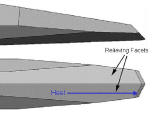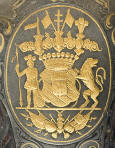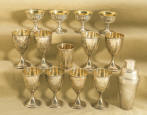HAIRLINES – A cut of minimum width and depth in script
lettering, executed with a finely pointed graver that connects letters.
Also known as a “kern.”
|
HAMMER – On cartridge firing firearms, the hammer is the piece
that pivots on an axis to deliver a blow to the firing pin. The hammers
of engraved firearms are often engraved with scrollwork but are
sometimes engraved with stylized dog, dragon, or wolf heads. See
DRAGON
HEAD HAMMER.
|
HAND ENGRAVER/FREEHAND ENGRAVER – One who engraves into metal
with a graver, either manually or power driven, which the engraver
controls entirely freehand. A hand engraver can be contrasted to a
machine engraver who performs the set-up of an engraving machine after
which the machine performs the engraving either by electric or manual
power.
|
HAND ENGRAVING – Engraving executed by a hand engraver using a
burin, a bulino, a chisel or a graver mounted in a power tool and
controlled in an entirely freehand manner. In general usage,” hand
engraving” usually refers to engraved objects de Art, jewelry, items of
utility such as guns or knives, or musical instruments as contrasted
with “engraving” which is understood to indicate engraved printing
plates or wood blocks for the reproduction of art or banknotes.
|
HAND GRAVER – A common engraver’s term for a burin.
|
HATCHING - An artistic technique used to create tonal or shading
effects by drawing or engraving closely spaced parallel lines. When
such lines are placed at an angle to one another, it is called
cross-hatching. Hatching and cross-hatching are especially important in
essentially linear media, such as drawing, and many forms of
printmaking, such as engraving, etching and woodcut. Gun and knife
engravers, when referring to the hatching of leaves, flowers and vines,
call this “shading” but the term cross-hatching is still used when the
shading or hatching lines are crossed at an angle with additional
lines.

Pictured is an example of hatching used in the shading of scroll
leaves.
|
HEEL – That portion of a graver that is below the face and is
ground into the tool to provide additional lift for hand clearance and
promote better steering control. Heels are usually ground to provide
between 10 and 20 degrees of lift depending on the object being
engraved and the type of hand piece in which the graver is mounted.

|
HERALDRY – As it applies to hand engravers, heraldry is the art
of blazoning armorial bearings on armor, seals, signets, and weapons.
Some hand engravers are specialists in the field of crests and coats of
arms with the majority of their work on signet rings.

Pitured is an example of a raised gold inlayed crest as part of an
antique gun.
|
HIGH SPEED STEEL - High speed steel (often abbreviated HSS,
sometimes HS) is a material usually used in the manufacture of machine
tool bits and other cutters including gravers. It is often used in
power saw blades and drill bits. It is superior to the older high
carbon steel tools used extensively through the 1940s in that it can
withstand higher temperatures without losing its temper (hardness).
This property allows HSS to cut faster than high carbon steel, hence
the name high speed steel. High speed steel is the most common alloy
used in the manufacture of traditional graver blanks because of its
combination of toughness, chip resistance, and ability to be sharpened
on a bench stone rather than diamond laps or hones.
|
HINTERGRUNDS – German: Background treatment of ornamental
scroll, motifs, or scenes.
|
HOB – In the manufacturing industry, the term “hob” is used to
describe what is known as a “hub” in the jewelry and award industry. A
hob is the male counterpart of a die. Hobs are often used as a master
to create additional dies of the same design.
|
HOLLOWWARE – As referenced by engravers, hollowware is a
collective term for silver table items such as chocolate pots, coffee
pots, or teapots, bowls, or cups. Engraving on these items is usually
limited to ciphers, crests, initials, or monograms. Occasionally other
engraved decoration is applied however scroll and floral decoration is
usually applied by repousse or with dies.

|
HUB – In the jewelry and award industry, the term “hub” is used
to describe what is known as a “hob” in the manufacturing industry. A
hub is the male counterpart of a die. Hubs are often used as a master
to create additional dies of the same design.
|
HUNT ENGRAVED – Sporting gun dealers and gun auction catalogs
frequently use the description “Hunt engraved”. This does not mean that
the gun in question is engraved with a hunting scene or is to be used
for hunting. It is a reference to British engraver Ken Hunt, whose
career as a gun engraver spanned 58 years, eclipsing the longevity of
such notables as L.D. Nimschke. Hunt was apprenticed at an early age to
the late Harry Kell of London who likewise had a lengthy and honored
career. Ken Hunt is a pioneer in techniques of design and execution
that took gun engraving from the realm of a decorative trade to an art
form in the second half of the 20th century and into the 21st until his
retirement from gun work in 2009. Mr. Hunt also apprenticed his
daughter Allison and son Marcus as engravers. Ken Hunt is also notable
as a Grand Master instructor of engraving.
|